Five S for Quality Ambience Time

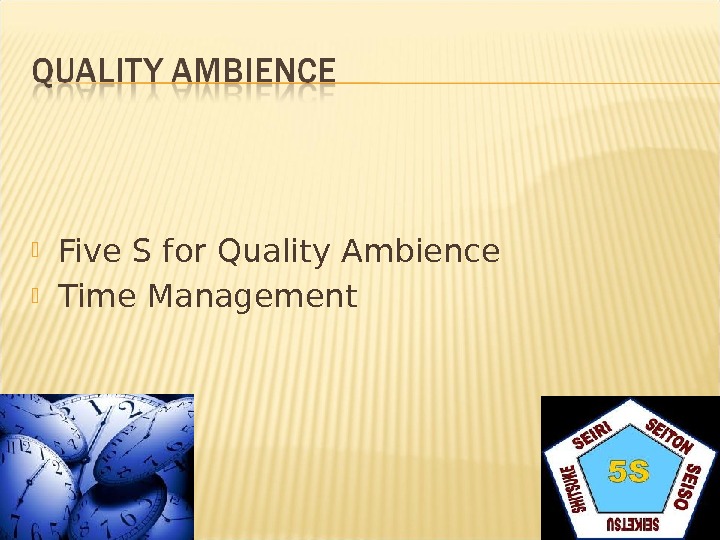
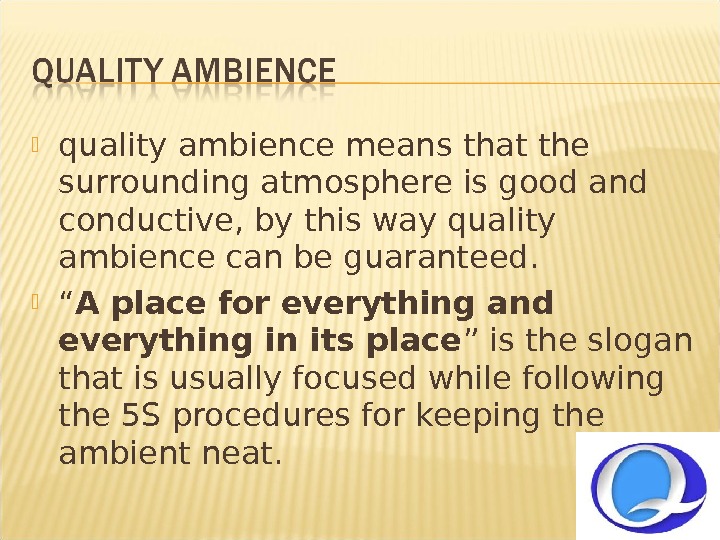
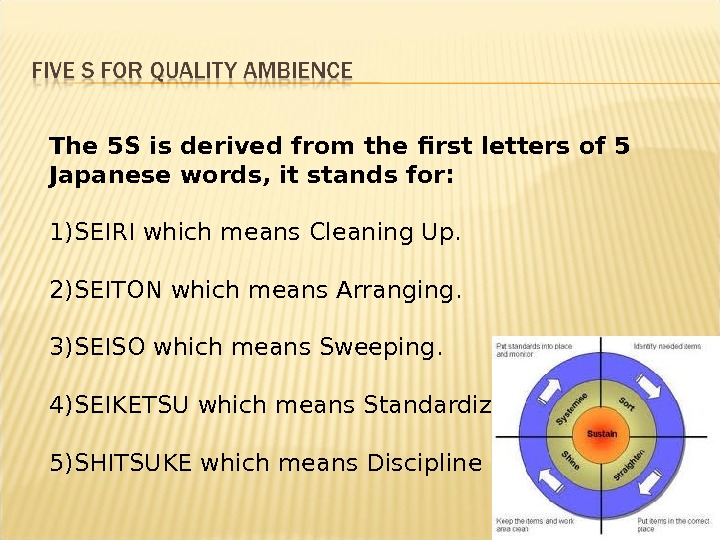
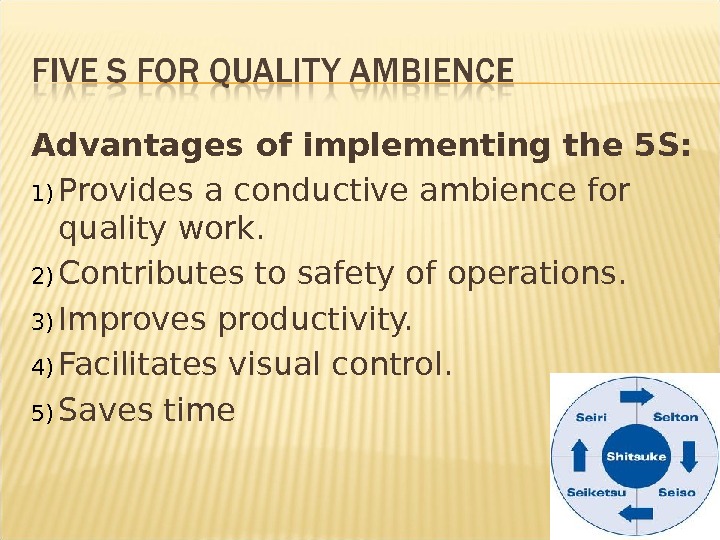
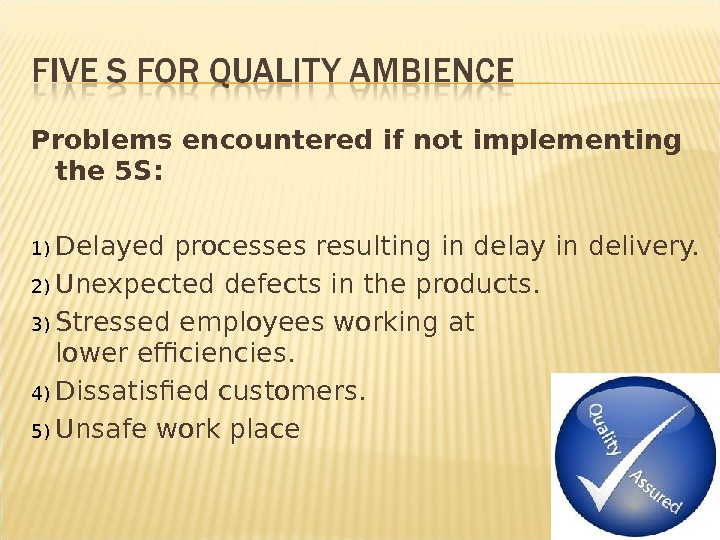
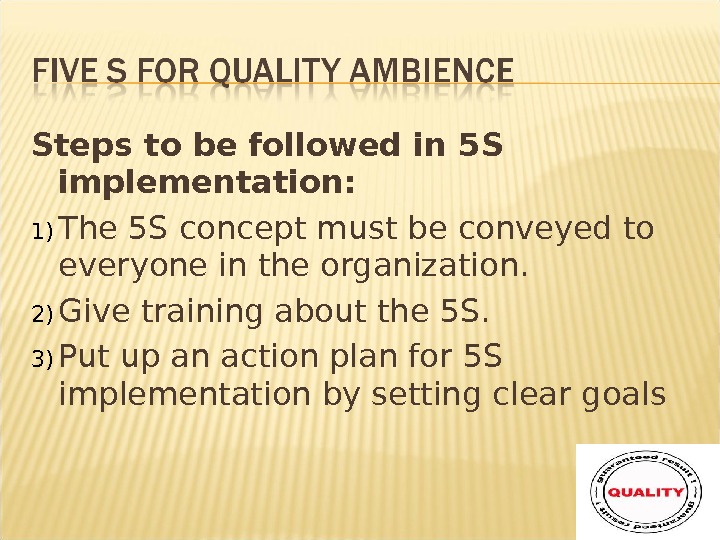
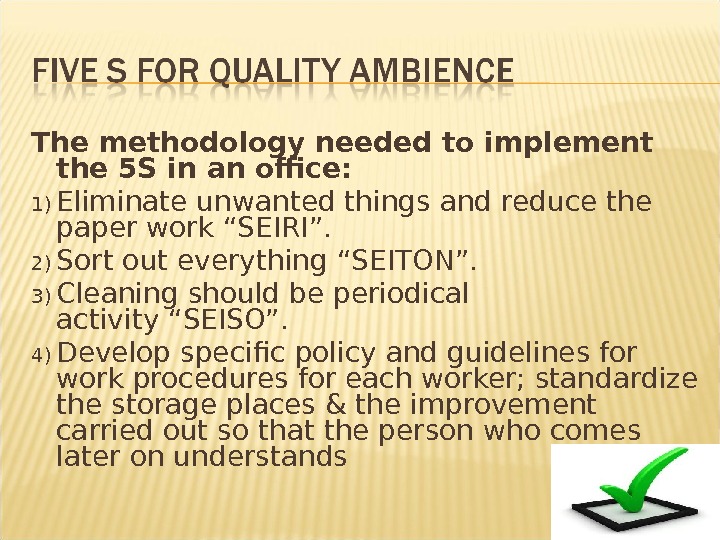
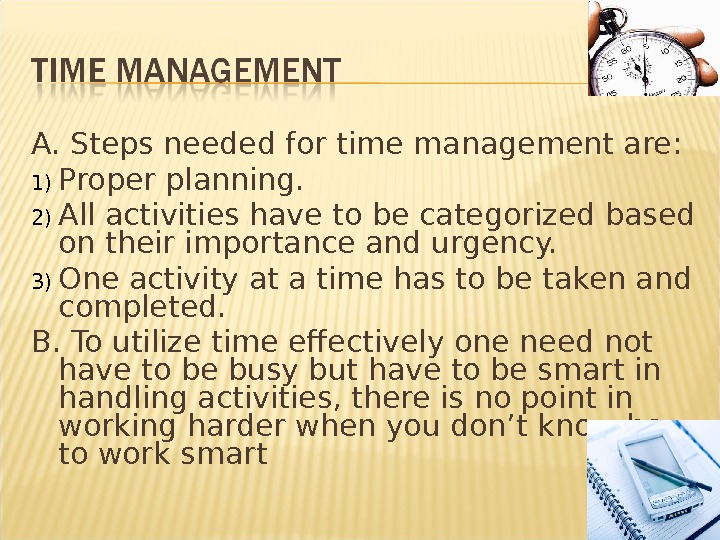
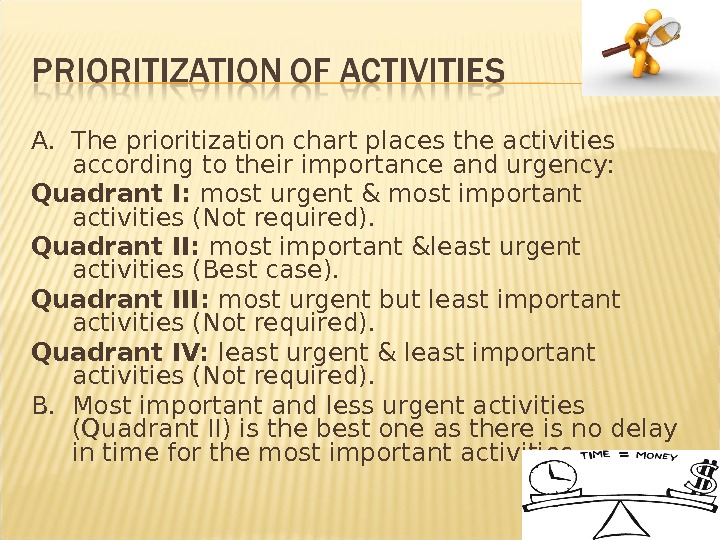
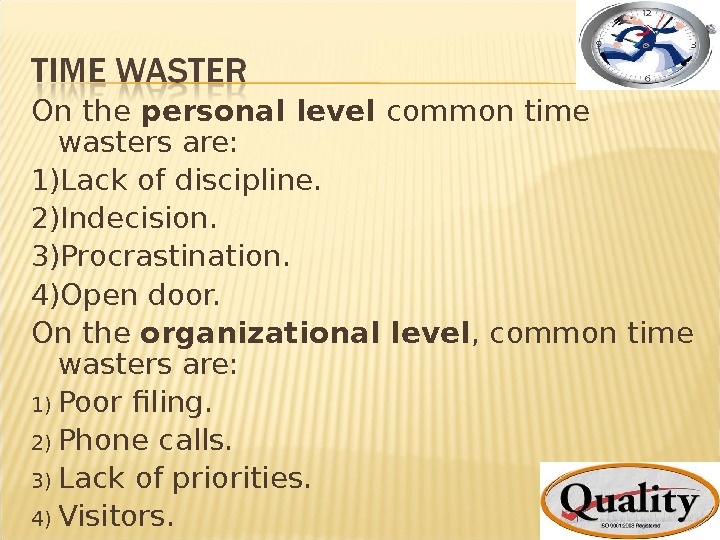
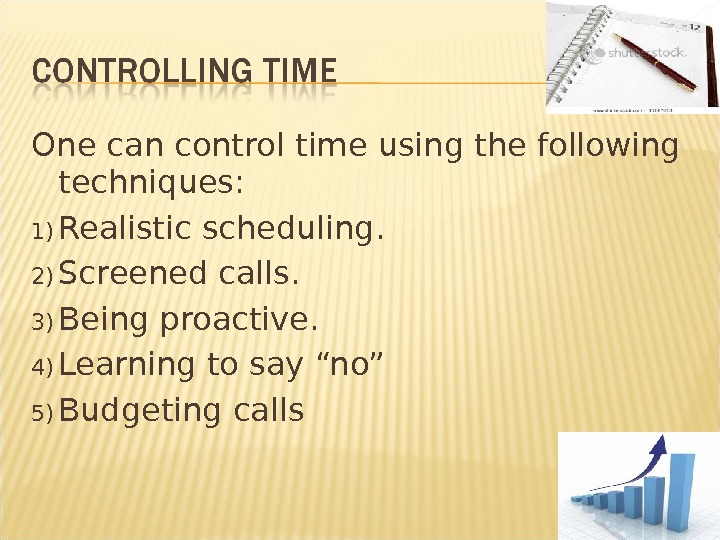
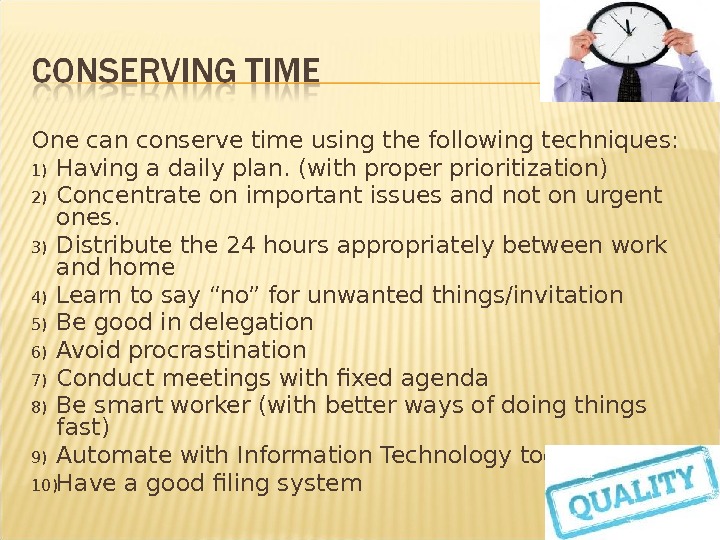
- Размер: 1.8 Mегабайта
- Количество слайдов: 12
Описание презентации Five S for Quality Ambience Time по слайдам
 Five S for Quality Ambience Time Management
Five S for Quality Ambience Time Management
 quality ambience means that the surrounding atmosphere is good and conductive, by this way quality ambience canbe guaranteed. “ A place for everything and everything in its place ” is the slogan that is usually focused while following the 5 S procedures for keeping the ambient neat.
quality ambience means that the surrounding atmosphere is good and conductive, by this way quality ambience canbe guaranteed. “ A place for everything and everything in its place ” is the slogan that is usually focused while following the 5 S procedures for keeping the ambient neat.
 The 5 S is derived from the first letters of 5 Japanese words, it stands for: 1) SEIRI which means Cleaning Up. 2) SEITON which means Arranging. 3) SEISO which means Sweeping. 4) SEIKETSU which means Standardizing. 5) SHITSUKE which means Discipline
The 5 S is derived from the first letters of 5 Japanese words, it stands for: 1) SEIRI which means Cleaning Up. 2) SEITON which means Arranging. 3) SEISO which means Sweeping. 4) SEIKETSU which means Standardizing. 5) SHITSUKE which means Discipline
 Advantages of implementing the 5 S: 1) Provides a conductive ambience for quality work. 2) Contributes to safety of operations. 3) Improves productivity. 4) Facilitates visual control. 5) Saves time
Advantages of implementing the 5 S: 1) Provides a conductive ambience for quality work. 2) Contributes to safety of operations. 3) Improves productivity. 4) Facilitates visual control. 5) Saves time
 Problems encountered if not implementing the 5 S: 1) Delayed processes resulting in delay in delivery. 2) Unexpected defects in the products. 3) Stressed employees working at lowerefficiencies. 4) Dissatisfied customers. 5) Unsafe work place
Problems encountered if not implementing the 5 S: 1) Delayed processes resulting in delay in delivery. 2) Unexpected defects in the products. 3) Stressed employees working at lowerefficiencies. 4) Dissatisfied customers. 5) Unsafe work place
 Steps to befollowed in 5 S implementation: 1) The 5 S concept must beconveyed to everyone in theorganization. 2) Give training about the 5 S. 3) Put up anaction plan for 5 S implementation by setting cleargoals
Steps to befollowed in 5 S implementation: 1) The 5 S concept must beconveyed to everyone in theorganization. 2) Give training about the 5 S. 3) Put up anaction plan for 5 S implementation by setting cleargoals
 The methodology needed to implement the 5 S in an office: 1) Eliminate unwanted things and reducethe paper work“SEIRI”. 2) Sort outeverything “SEITON”. 3) Cleaning should be periodical activity“SEISO”. 4) Develop specific policy and guidelines for work procedures for each worker; standardize the storage places & the improvement carried out so that the personwho comes later on understands
The methodology needed to implement the 5 S in an office: 1) Eliminate unwanted things and reducethe paper work“SEIRI”. 2) Sort outeverything “SEITON”. 3) Cleaning should be periodical activity“SEISO”. 4) Develop specific policy and guidelines for work procedures for each worker; standardize the storage places & the improvement carried out so that the personwho comes later on understands
 A. Steps needed for time management are: 1) Proper planning. 2) All activities have to be categorized based on their importance and urgency. 3) One activity at a time has to betaken and completed. B. To utilize time effectively one need not have tobe busy but have tobe smart in handling activities, there is no point in working harder when you don’t know how to work smart
A. Steps needed for time management are: 1) Proper planning. 2) All activities have to be categorized based on their importance and urgency. 3) One activity at a time has to betaken and completed. B. To utilize time effectively one need not have tobe busy but have tobe smart in handling activities, there is no point in working harder when you don’t know how to work smart
 A. The prioritization chart places the activities according to their importance and urgency: Quadrant I: most urgent & most important activities (Not required). Quadrant II: most important &least urgent activities (Best case). Quadrant III: most urgent but least important activities (Not required). Quadrant IV: least urgent & least important activities (Not required). B. Most important and less urgent activities (Quadrant II) is the best one as there is no delay in time for themost important activities
A. The prioritization chart places the activities according to their importance and urgency: Quadrant I: most urgent & most important activities (Not required). Quadrant II: most important &least urgent activities (Best case). Quadrant III: most urgent but least important activities (Not required). Quadrant IV: least urgent & least important activities (Not required). B. Most important and less urgent activities (Quadrant II) is the best one as there is no delay in time for themost important activities
 On the personal level common time wasters are: 1) Lack of discipline. 2) Indecision. 3) Procrastination. 4) Open door. On the organizational level , common time wasters are: 1) Poor filing. 2) Phone calls. 3) Lack of priorities. 4) Visitors.
On the personal level common time wasters are: 1) Lack of discipline. 2) Indecision. 3) Procrastination. 4) Open door. On the organizational level , common time wasters are: 1) Poor filing. 2) Phone calls. 3) Lack of priorities. 4) Visitors.
 One can control time using thefollowing techniques: 1) Realistic scheduling. 2) Screened calls. 3) Being proactive. 4) Learning to say “no” 5) Budgeting calls
One can control time using thefollowing techniques: 1) Realistic scheduling. 2) Screened calls. 3) Being proactive. 4) Learning to say “no” 5) Budgeting calls
 One can conserve time using thefollowing techniques: 1) Having a daily plan. (with proper prioritization) 2) Concentrate on important issues and not on urgent ones. 3) Distribute the 24 hours appropriately between work and home 4) Learn to say “no” for unwanted things/invitation 5) Be good in delegation 6) Avoid procrastination 7) Conduct meetings with fixed agenda 8) Be smart worker (with better ways of doing things fast) 9) Automate with Information Technology tools 10) Have a good filing system
One can conserve time using thefollowing techniques: 1) Having a daily plan. (with proper prioritization) 2) Concentrate on important issues and not on urgent ones. 3) Distribute the 24 hours appropriately between work and home 4) Learn to say “no” for unwanted things/invitation 5) Be good in delegation 6) Avoid procrastination 7) Conduct meetings with fixed agenda 8) Be smart worker (with better ways of doing things fast) 9) Automate with Information Technology tools 10) Have a good filing system

